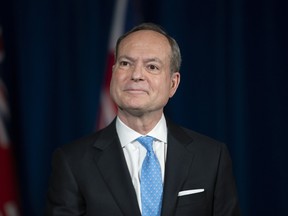Ontario budget promises billions for infrastructure, critical minerals; could eliminate deficit sooner than expected

Doug Ford’s government said the economic recovery plan could eliminate Ontario’s deficit two years earlier than projected

Article content
In a budget delivered just over a month before voters head to the polls, in what amounts to an election platform, the Ontario government is promising to invest billions of dollars during the next three to five years to shore up infrastructure, boost the supply of critical minerals and commercialize promising technologies.
Advertisement 2
Story continues below
Article content
Despite the spending, the government said the economic recovery plan laid out Thursday could eliminate Ontario’s deficit two years earlier than projected in the 2021 budget.
Echoing the recent federal promise to invest billions of dollars in critical minerals development this decade, Finance Minister Peter Bethlenfalvy unveiled a five-year roadmap to boost the province’s ability to supply critical minerals such as cobalt and nickel, including $4 million in each of the next three years to create a new critical minerals stream. The economic plan for Canada’s most populous province also committed $1 billion to critical infrastructure, including all-season roads to the Ring of Fire mining district in northern Ontario.
Advertisement 3
Story continues below
Article content
“Critical minerals will become part of the future of clean steel, batteries and hybrid and electric vehicles as the next generation of automobiles are built in Ontario… and sold across North America and the world,” Doug Ford’s government said in statement unveiling the budget promises.
Critical minerals will become part of the future
In further symmetry with Ottawa, the Ontario budget included commitments to technology and innovation, promising to invest nearly $107 million over the next three years to commercialize promising tech.
In addition, venture capital funding through Venture Ontario will triple to $300 million.
A further $25 million has been earmarked by the government to provide working capital to Indigenous-owned businesses and entrepreneurs over three years through the Indigenous Economic Development Fund.
Advertisement 4
Story continues below
Article content
Despite investments and enticements for voters — including a promise to invest more than $85 billion over the next 10 years to build highways, transit and other infrastructure projects to fight gridlock, boost the economy and create jobs — Ontario is projected to return to a surplus position by 2027–28.
That’s two years earlier than previous estimates. The government is projecting a budget shortfall of $19.9 billion in 2022–23, up from $13.5 billion in the year ended March 31. After that it declines steadily to $12.3 billion in 2023–24 and $7.6 billion in 2024–25.

“This is our blueprint coming out of two years of the pandemic,” Bethlenfalvy said, acknowledging that the budget won’t be passed before the June 2 election.
Advertisement 5
Story continues below
Article content
“We are going to campaign on this document,” he said, declining to answer whether it would be tabled exactly as written if his Progressive Conservative party is re-elected.
The Canadian Taxpayers Federation expressed disappointment there is “no broad-based tax relief” in the budget and criticized the decision to continue to run deficits, but said an income tax break for low-income Ontarians was the “brightest point.”
Jay Goldberg, the tax federation’s Ontario director, said the provincial tax break will benefit more than one million people earning less than $50,000 a year, leaving as much as $850 in their wallets.
“As Ontarians face soaring living costs, this tax break will make a meaningful difference for a large group of taxpayers… but the government should be looking to extend income tax relief to help millions of other taxpayers,” he said.
Advertisement 6
Story continues below
Article content
-

Tiff Macklem acknowledges misjudging inflation, pledges to act ‘forcefully’ to bring it down
-

U.S. economy posts surprise contraction for first time since 2020
-

What rapidly rising inflation tells us about the economy
The Ontario government pre-announced a couple of items, including a minimum wage increase to $15.50 an hour, effective this fall, a move that would normally upset business owners but could help them attract employees in difficult labour conditions that followed pandemic-related lockdowns. The government is also pledging to invest $1 billion in employment and training programs, and invest an additional $114.4 million over three years to promote skilled trades and simplify the system.
Rocco Rossi, chief executive of the Ontario Chamber of Commerce, said the promised investments in the government’s skilled trades strategy would help address Ontario’s current labour shortages and future workforce needs, alongside commitments to reduce barriers to foreign credentials.
Advertisement 7
Story continues below
Article content
But he called on all parties to do more to address supply chain issues exposed by the COVID-19 pandemic and geopolitical unrest, and to ease interprovincial trade and labour mobility.
On Thursday, Bethlenfalvy reiterated his government’s pledge to increase housing supply and speed up approvals for all types of housing, following a March announcement to increase the Non-Resident Speculation Tax to 20 per cent from 15 per cent to try to rein in soaring home prices.
“We’ve set a target of 1.5 million new homes over the next 10 years,” he said. “It’s a supply issue.”
But New Democratic Party leader Andrea Horwath said the Ford government has missed the mark so far on the types of housing and policies that will get people into their first homes.
• Email: bshecter@nationalpost.com | Twitter: BatPost
Advertisement
Story continues below








